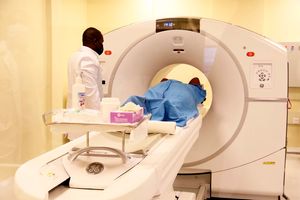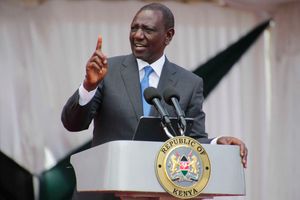Inside hospital where medics go undercover to treat patients as strike hits 40-day mark

In some parts of the country, medical services have not been interrupted in many public health facilities despite the ongoing doctors’ strike.
What you need to know:
- As doctors and their employer’s face-off on Day 40 of a debilitating nationwide strike, a Nation reporter on a secret mission finds hidden gems in one public hospital.
On a cold Wednesday morning, the air around a hospital in Murang’a is abuzz with activity as tens, perhaps hundreds, of patients and their minders scurry along wide corridors, tens of others mill outside the main administration block and ward zones, and many more others make the short walk to the main gate with varying emotions written on their faces.
Outside the precincts of this vital medical facility in Murang’a County, boda boda riders wait for passengers. Doctors, clinical officers and medical laboratory technicians have been on strike for a cumulative 40 days as at Monday, April 2024, their absence from hospitals causing untold suffering among patients and sending many to their early graves, yet in this corner of the country, everything seems to be running according to plan. But here, in the middle of one of the most debilitating industrial actions by doctors countrywide, all appears to be well.
What is happening? I wonder as I walk around the hospital. How is this facility weathering the storms of the strike?
I am an undercover journalist on this assignment, posing as a patient seeking treatment for a bad stomach upset. My mission begins at the reception desk, where my details are captured in the hospital’s digital patient management system. For a moment, a flicker of uncertainty clouds the receptionist’s eyes as she scans me up and down.
“What do you want…?” her question, in Kiswahili, trails off mid-sentence.
“I’d like to see a medical officer,” I tell her.
She points me towards a row of benches with tens of waiting patients.
“But go there first,” she says, pointing to a makeshift triage area where my blood pressure and other vital data will be taken.
A lifeline for patients
At the waiting area, I sit next to a young woman in her 20s who tells me that she is here to seek treatment for a perennial stomach upset that has gotten worse over the past few months. At first, she had sought treatment at a public hospital in Nairobi County and was turned away. Then she went to a private facility but couldn’t afford to pay for the required tests, she says.
This particular hospital is a lifeline for her and for many patients here as whispers of rejections from other public health facilities and exorbitant private healthcare costs are two lines I frequently hear in my interactions with other patients.
The queues are long and services annoyingly slow. But, the functionality of the facility is everyone’s small miracle, so we wait. And wait. And wait.
And then, as I observe the movements of medical personnel, it occurs to me that it is hard to verify their positions – doctors, nurses, clinical officers, pharmacists – as they are all in civilian attired.
Every now and then someone scurries past us with a stethoscope or other medical equipment hanging from their necks or tightly clutched in their hands, but many cadres of medical personnel carry these items. I had hoped to find out whether patients here are being attended to by doctors or other cadres, but it appears that it would be difficult to establish that by just observing their movements and listening to their conversations.
After what feels like eternity I am ushered into a consultation room. The clinical officer, with the name badge displaying the initials ‘CO’ prominently on the lab coat, greets me warmly. In the next room, I notice the person seeing patients isn’t wearing a lab coat but is, instead, in plain clothes.
Snippets of conversation drift through the doorway, hinting at the nature of his examination. I later observe many patients walking in and out of the room, with some being directed to the laboratory or the pharmacy.
“The doctor (referring to the clinical officer) has sent me to the pharmacy for some medications. He had earlier directed me to the laboratory where I was tested for malaria,” Ms Nancy Mwangi, a resident of Kiharu, shares.
A worker at the facility says that some of the doctors are also working undercover. However, I don’t get to see or interact with any as I am told that my issue is not “serious”. After discussing my symptoms with the attending medic, he recommends a malaria test that costs me Sh300 at the laboratory.
Critical care
For those who come to the hospital in critical condition, a small note is written for them so that they can access the “doctor” in the Casualty department. The hospital representative, hinting at the possibility that doctors here are working undercover, say that anonymity would protect the healthcare workers from potential repercussions from their striking colleagues, who are likely to view them as traitors to their cause.
The Council of Governors has been issuing threats to striking medics to the effect that if they do not return to work they would be sacked and immediately replaced, and while it is not clear to us as we observe the situation in Murang’a whether those working heeded the directive to return to work, the suggestion that they are doing so under the cover of anonymity is telling.
In some parts of the country, medical services have not been interrupted in many public health facilities despite the ongoing doctors’ strike. In Lamu County, for instance, the Nation found that out of the 48 medical specialists, including doctors and pharmacists, stationed in the County, only 14 are taking part in the strike.
Meanwhile, the Council of Governors maintains its position that the strike is illegal and the demands untenable.
Ms Anne Waiguru, the Kirinyaga Governor who is also the Council’s chairperson, notes that, “as duty bearers”, governors “cannot afford to remain silent as Kenyans continue to suffer and in other unfortunate cases, die, due to an unprotected strike”.
“The Constitution defines doctors as essential workers and therefore they are not expected to abandon their stations of duty,” she says.
But Dr Dennis Miskellah, the Deputy Secretary-General of the medics’ union, says that the return of duty by some healthcare workers will not deter the union officials from advocating for the rights of the healthcare workers.
“A union is about all of us or none of us. As their leaders, we will continue championing for the doctors’ rights and will bravely pursue those ideals. Even if all of them will walk back to work, we will still be there championing that they should remain on strike because we will not an adjourned back-to-work agreement that condemns the fate of the medical officers,” he says.
The striking health workers and the national government are back at the negotiating table after a court order instructed them to work out a return-to-work formula within the next 30 days, but so far no agreements have been reached yet.





